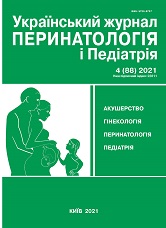Clinical features of measles in children under 3 years
DOI:
https://doi.org/10.15574/PP.2021.88.78Keywords:
measles, complications, young children, infantsAbstract
Measles occurs at any age. Outbreaks appear to be exacerbated during periods of low vaccination coverage. In Ukraine in 2016, the level of vaccinations with the first dose was only in 45% of children, and the second — in 31%. Thus, during 2017 only in the Odessa region the number of measles patients reached 1 016.
The purpose was to identify the features of the clinical course of measles in young children and infants.
Materials and methods. A retrospective study of the medical histories of 111 young children, 68 of them in the first year of life.
Results. Measles in children 3 years old retains the typical features of acute onset, manifestations of intoxication (71.82%), fever (99.09%), cough (94.55%), catarrhal phenomena and rash. At the same time, rhinitis (95.59%) and puffiness of the face (100%) are characteristic of children under one year compared with children 1–3 years (51.16% and 58.14%, respectively) p<0.001. Measles severity depends on the age of the child (in children (35.29%) younger than 12 months there was a severe course, and in (55.62%) children younger than 6 months). Complications were found in (44.14%) children. Among them, pneumonia (32.35%) is more common in children under 1 year of age, bronchitis (18.6%) and pneumonia (16.28%) in children aged 1–3 years are approximately the same in frequency. Otitis media (7.35%) was found only in children under 12 months.
Conclusions. Thus, the clinical manifestations, severity and complications of measles depend on the age of the child, and the presence of children less than 6 months (28.81%) indicates the existence of a non3immune layer among women of childbearing age.
The research was carried out in accordance with the principles of the Helsinki Declaration. The study protocol was approved by the Local ethics committee of the participating institution. The informed consent of the patient was obtained for conducting the studies.
No conflict of interest was declared by the authors.
References
ECDC. (2017). Surveillance Report: Measles and rubella monitoring February 2014. European Centre for Disease Prevention and Control (ECDC).
Goncharov VO, Kotlyk LS, Skopenko AV, Gruzevsky OA et al. (2019). Epidemic indicators of measles in Odessa region. Current infectology. 7 (2): 32–37.
Ivanova LA, Garaz MN, Bileychuk RY, Ruda TD. (2019). Variants of congenital measles: difficulties in diagnosis and optimization of treatment. Topical infectology. 7 (1): 76.
Kirienko VT, Zaitsev IA, Potiy VV, Grushkevich VV. (2019). Bark prevention. Topical infectology. 7 (2): 49–51.
MOZ Ukrainy. (2018). Operatyvni dani shchodo zakhvoriuvanosti na kir: 40-y tyzhden. URL: http://moz.gov.ua/article/news/operativni-dani-zahvorjuvanosti-na-kir-40-tizhden.
WHO. (2018). Measles cases hit record high in the European Region. WHO. URL: http://www.euro.who.int/ru/media-centre/sections/press-releases/2018/measlescases-hit-record-high-in-the-european-region.
Woudenberg T, van Binnendijk RS, Sanders EA et al. (2017). Large measles epidemic in the Netherlands, May 2013 to March 2014: changing epidemiology. Euro Surveill. 22: 30443. https://doi.org/10.2807/1560-7917.ES.2017.22.3.30443; PMid:28128092 PMCid:PMC5322286
Downloads
Published
Issue
Section
License
Copyright (c) 2022 Ukrainian journal of Perinatology and Pediatrics

This work is licensed under a Creative Commons Attribution-NonCommercial 4.0 International License.
The policy of the Journal “Ukrainian Journal of Perinatology and Pediatrics” is compatible with the vast majority of funders' of open access and self-archiving policies. The journal provides immediate open access route being convinced that everyone – not only scientists - can benefit from research results, and publishes articles exclusively under open access distribution, with a Creative Commons Attribution-Noncommercial 4.0 international license(СС BY-NC).
Authors transfer the copyright to the Journal “MODERN PEDIATRICS. UKRAINE” when the manuscript is accepted for publication. Authors declare that this manuscript has not been published nor is under simultaneous consideration for publication elsewhere. After publication, the articles become freely available on-line to the public.
Readers have the right to use, distribute, and reproduce articles in any medium, provided the articles and the journal are properly cited.
The use of published materials for commercial purposes is strongly prohibited.

